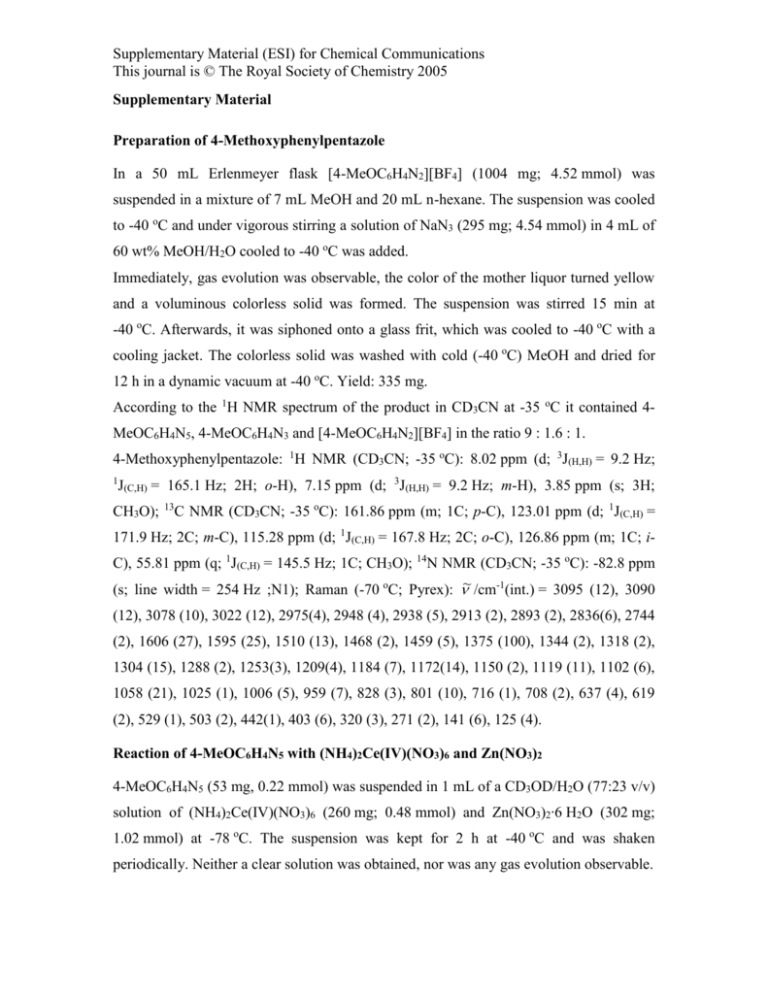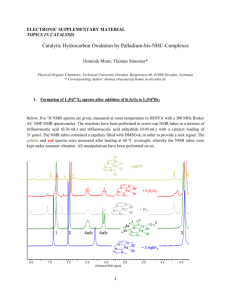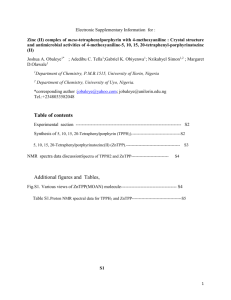Experimental details and NMR spectra
advertisement

Supplementary Material (ESI) for Chemical Communications This journal is © The Royal Society of Chemistry 2005 Supplementary Material Preparation of 4-Methoxyphenylpentazole In a 50 mL Erlenmeyer flask [4-MeOC6H4N2][BF4] (1004 mg; 4.52 mmol) was suspended in a mixture of 7 mL MeOH and 20 mL n-hexane. The suspension was cooled to -40 oC and under vigorous stirring a solution of NaN3 (295 mg; 4.54 mmol) in 4 mL of 60 wt% MeOH/H2O cooled to -40 oC was added. Immediately, gas evolution was observable, the color of the mother liquor turned yellow and a voluminous colorless solid was formed. The suspension was stirred 15 min at -40 oC. Afterwards, it was siphoned onto a glass frit, which was cooled to -40 oC with a cooling jacket. The colorless solid was washed with cold (-40 oC) MeOH and dried for 12 h in a dynamic vacuum at -40 oC. Yield: 335 mg. According to the 1H NMR spectrum of the product in CD3CN at -35 oC it contained 4MeOC6H4N5, 4-MeOC6H4N3 and [4-MeOC6H4N2][BF4] in the ratio 9 : 1.6 : 1. 4-Methoxyphenylpentazole: 1H NMR (CD3CN; -35 oC): 8.02 ppm (d; 3J(H,H) = 9.2 Hz; 1 J(C,H) = 165.1 Hz; 2H; o-H), 7.15 ppm (d; 3J(H,H) = 9.2 Hz; m-H), 3.85 ppm (s; 3H; CH3O); 13 C NMR (CD3CN; -35 oC): 161.86 ppm (m; 1C; p-C), 123.01 ppm (d; 1J(C,H) = 171.9 Hz; 2C; m-C), 115.28 ppm (d; 1J(C,H) = 167.8 Hz; 2C; o-C), 126.86 ppm (m; 1C; iC), 55.81 ppm (q; 1J(C,H) = 145.5 Hz; 1C; CH3O); 14N NMR (CD3CN; -35 oC): -82.8 ppm (s; line width = 254 Hz ;N1); Raman (-70 oC; Pyrex): ~ /cm-1(int.) = 3095 (12), 3090 (12), 3078 (10), 3022 (12), 2975(4), 2948 (4), 2938 (5), 2913 (2), 2893 (2), 2836(6), 2744 (2), 1606 (27), 1595 (25), 1510 (13), 1468 (2), 1459 (5), 1375 (100), 1344 (2), 1318 (2), 1304 (15), 1288 (2), 1253(3), 1209(4), 1184 (7), 1172(14), 1150 (2), 1119 (11), 1102 (6), 1058 (21), 1025 (1), 1006 (5), 959 (7), 828 (3), 801 (10), 716 (1), 708 (2), 637 (4), 619 (2), 529 (1), 503 (2), 442(1), 403 (6), 320 (3), 271 (2), 141 (6), 125 (4). Reaction of 4-MeOC6H4N5 with (NH4)2Ce(IV)(NO3)6 and Zn(NO3)2 4-MeOC6H4N5 (53 mg, 0.22 mmol) was suspended in 1 mL of a CD3OD/H2O (77:23 v/v) solution of (NH4)2Ce(IV)(NO3)6 (260 mg; 0.48 mmol) and Zn(NO3)2∙6 H2O (302 mg; 1.02 mmol) at -78 oC. The suspension was kept for 2 h at -40 oC and was shaken periodically. Neither a clear solution was obtained, nor was any gas evolution observable. Supplementary Material (ESI) for Chemical Communications This journal is © The Royal Society of Chemistry 2005 The suspension was centrifuged at -78 oC and the solid was investigated by Raman spectroscopy at -70 oC. Only signals belonging to 4-MeOC6H4N5, 4-MeOC6H4N3 and (NH4)2Ce(IV)(NO3)6, respectively, were detectable. The sample was slowly warmed from -78 oC to r.t. over a period of 2 d. The decomposition products found in the yellow mother liquor were 4-MeOC6H4N3 (14N NMR: -135.25 ppm (s, 1N, N; -145.27 ppm (s, 1N, N)), NO3- (14N NMR: -7.63 ppm (s, 1N, NO3-)) and NH4+ (14N NMR: -360.59 ppm (m, 1N, NH4+)) in a ratio of 1 : 23.6 : 4.9. The colorless solid was identified as 4-MeOC6H4N3 by Raman spectroscopy. In a separate experiment 4-MeOC6H4N5 (166 mg; 0.70 mmol) was suspended in a solution of (NH4)2Ce(IV)(NO3)6 (766 mg; 1.40 mmol) and Zn(NO3)∙6 H2O (888 mg; 2.99 mmol) in 3.25 mL CD3OD/H2O (77 : 23 v/v) at -78 oC. The suspension was stirred for 1 h at -40 oC. After the stirring was stopped, the suspension was kept for 60 min at -40 oC. After the voluminous solid settled, a sample of the dark red, highly viscous mother liquor was siphoned into an NMR tube cooled to -78 oC. Only NO3- (14N NMR: 0.36 ppm (broad s (line width = 1761 Hz), 1N, NO3-)) and NH4+ (14N NMR: -360.44 ppm (m, 1N, NH4+)) were observed. The NMR sample was recombined with the suspension and was stirred for 30 min at -20 oC. A sample was taken at -20 oC and investigated by NMR spectroscopy. Again, only NO3- (14N NMR: -6.71 ppm (broad s (line width = 758 Hz), 1N, NO3-); 15N NMR: 7.21 ppm (s, 1N, NO3-)) and NH4+ (14N NMR: -360.26 ppm (m, 1N, NH4+)) were detectable. Reaction of (NH4)2Ce(IV)(NO3)6 with NaN3 (NH4)2Ce(IV)(NO3)6 (146 mg; 0.27 mmol) was dissolved in 0.75 mL CD3OD at -40 oC. NaN3 (17 mg; 0.26 mmol) was added to the dark red solution at this temperature. Immediately, strong effervescence was observed and the color of the solution turned orange. After 48 h at r.t., the mother liquor was colorless, and a small amount of an orange solid precipitated. The azide anion was no longer observable in the spectrum of the mother liquor. 14 N NMR Supplementary Material (ESI) for Chemical Communications This journal is © The Royal Society of Chemistry 2005 Reaction of [4-MeOC6H4N2][BF4] with 15N labeled NaN3 [4-MeOC6H4N2][BF4] (226 mg; 1.02 mmol) was suspended in 3 mL MeOH at room temperature. Terminally 15 N labeled NaN3 (65 mg; 1.00 mmol) was added to the vigorously stirred suspension. Immediately, strong effervescence was observed and the color of the mother liquor turned red. The suspension was stirred until the N2 evolution ceased. All volatiles were removed in a dynamic vacuum at -20 oC, and the dark red residue was extracted two times with CH2Cl2 (0.5 mL). The CH2Cl2 fractions were combined, the volume was reduced to ca. 0.3 mL and investigated by 15N NMR spectroscopy. 4-Methoxyphenylazide: 15 N NMR (CH2Cl2; r.t.): -137.62 ppm (s; 1N; N), -149.80 ppm (s; 1N; N); ratio = 1 : 3.9; 15 N NMR (CD3OD; r.t.): -135.50 ppm (s; 1N; N), -148.16 ppm (s; 1N; N). NMR spectrum of a mixture of (NH4)2Ce(IV)(NO3)6 and Zn(NO3)2 in CD3OD/H2O (NH4)2Ce(IV)(NO3)6 (772 mg; 1.41 mmol) and Zn(NO3)2∙6 H2O (894 mg; 3.01 mmol) were dissolved in a mixture of 2.50 mL CD3OD and 0.76 mL H2O. The dark red solution was investigated by 14N NMR and 15N NMR spectroscopy. The concentration of the nitrate anion is 4.44 mol/L which is equal to a concentration of naturally 15N labeled nitrate anion of 16 mmol/L. 14 N NMR (r.t.): -11.48 ppm (s; 1N; NO3-), -361.64 ppm (m; 1N; NH4+); ratio = 5 : 1; 15N NMR (r.t.): -11.46 ppm (s; 1N; NO3-). Supplementary Material (ESI) for Chemical Communications This journal is © The Royal Society of Chemistry 2005 Supplementary Material (ESI) for Chemical Communications This journal is © The Royal Society of Chemistry 2005 Supplementary Material (ESI) for Chemical Communications This journal is © The Royal Society of Chemistry 2005





